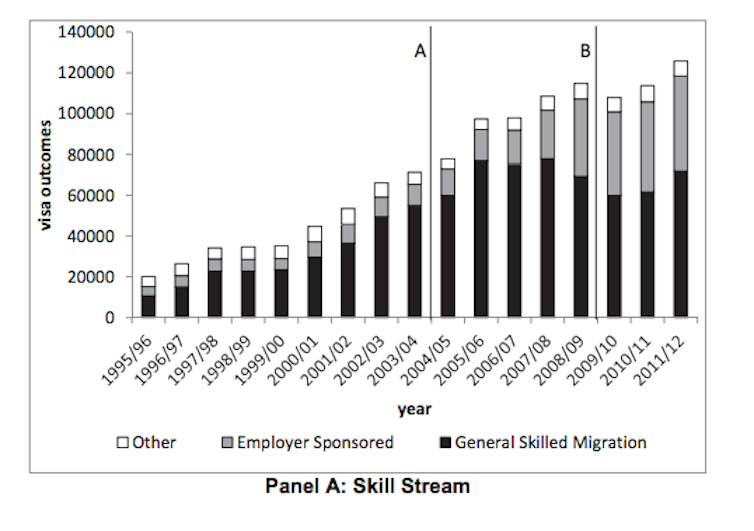Ask anyone on the street or in the pub about immigration and they’ll invariably say it’s all about boats, 457s and more boats. But immigration policy is obviously about more than just that, and in parallel to the eye catching headlines of Australia’s attempts to dissuade unwanted visitors or the jobs taken by temporary migrant workers, there has been an ongoing reform process that has dramatically affected Australian society.
In contrast to the often haphazard impression made by many policy reforms, the last two decades have seen a systematic transformation of Australia’s approach to managing skilled migrants; and encouragingly, this bipartisan effort seems to have changed things for the better.
On 1 July 1996, then Immigration Minister Philip Ruddock announced Australia would be taking in more skilled migrants to respond to our ageing population. Since then, the number of permanent additions to the country has increased from 99,000 in the year to July 1996 to 190,000 in 2006/7, a rate of migrant arrival not matched outside of two brief peaks in 1949/50 and 1969/70.
After that, the number of permanent additions to Australia has continued to grow, and exceeds 254,000 in the most recently available data (2012/13). The vast majority of this increase in Australia’s migrant intake was administered through the skill stream, which now accounts for around 6 out of every 10 permanent settlers admitted into the country.
Countries around the world currently rely on two main approaches for selecting skilled migrants. The government can select migrants from a pool of applicants on the basis of criteria that it sets, or it can subcontract the job of selecting migrants to employers.
Employers know best?
In the mid-2000s, countries including Australia tended to rely predominantly on one or the other of these approaches: in the case of Australia, the government selected four skilled migrants for every one selected by employers. Since then, Australia has instituted a range of reforms that tightened the conditions it uses to select skilled migrants at the same time as it promoted employer sponsored migration, so that by 2009/10 the numbers of skilled migrants selected by government and sponsored by employers were approximately equal.
The set of reforms that transformed the Australian system of skilled migration in the five years to 2010 were primarily motivated by the desire to achieve improved labour market outcomes among skilled migrants. When these reforms were implemented, however, it was unclear what effects they would have. Using the benefit of hindsight, and the availability of two good quality datasets (the Continuous Survey of Australia’s Migrants and the Longitudinal Survey of Immigrants to Australia), this shift in policy can now be evaluated.

The data reveals employment rates for skilled migrants increased by between 11 and 13 percentage points as a result of the shift in policy. Approximately 5 percentage points of this effect can be attributed to the increased use of employer sponsorship, with the remainder attributable in part to the tighter selection criteria imposed by government.
Of course, one concern is that increased employment rates for skilled migrants have been purchased at the cost of decreased job quality. Focusing exclusively on employed skilled migrants selected by the government, we found that the incidence of employment as managers or professionals increased by 5 percentage points as a result of the policy change. In contrast, we found no significant improvement in the incidence of employment as managers or professions among all skilled migrants.
This suggests that Australia’s shift towards a more equal sharing of skilled migrant selection by government and employers has had a broadly positive impact on average migrant labour market outcomes in their first year of permanent residency.
The findings for just the skilled migrants selected by government and the findings for all skilled migrants combined are consistent with a narrative where the government skims the cream of the pool of skilled migrant applicants, and requires weaker applicants to seek employer sponsorship as a pre-condition to settling in Australia.
Our estimates suggest this approach to policy has significantly improved the short-run employment outcomes of skilled migrants without an overall decline in occupational prestige. Something that Australia should be proud of.

